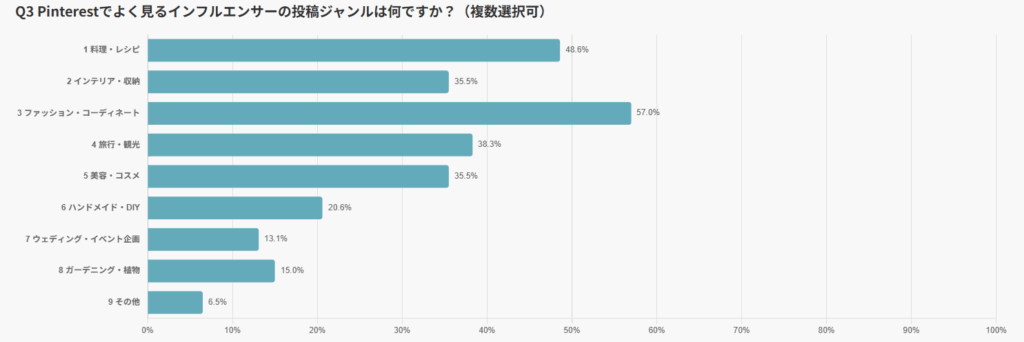How to Leverage Pinterest in the Japanese Market

INDEX
Are you considering using Pinterest for marketing but still wondering, “Is it really used in Japan?” or “Do posts actually lead to purchases?”
In reality, Pinterest is often thought to have limited adoption in Japan. However, our latest survey reveals a different truth: replicable, high-quality posts are already influencing consumer behavior.
In particular, influencer posts spark users’ desire to “try it out,” which can extend beyond purchases to actual lifestyle and habit changes.
In this article, we present a multifaceted analysis based on a survey of 125 Japanese Pinterest users, examining usage trends, popular content categories, and the qualities that make posts trusted and influential.
We also provide actionable insights for overseas brands looking to leverage Pinterest in the Japanese market, including tips on how to design influencer strategies that enhance engagement and drive consumer action.
Pinterest User Engagement and Usage Characteristics

Although Pinterest is not yet widely recognized as a mainstream SNS in Japan, actual usage data shows that many consumers are already incorporating it into their daily lives.

According to the survey, more than half of respondents use Pinterest at least once a month, and among them, about 86% reported being exposed to influencer posts. This indicates that influencer content functions as a “natural part of information exposure” for Japanese Pinterest users.

The most frequently viewed content categories were fashion, food, and travel—all closely tied to everyday life. This suggests that Japanese users primarily use Pinterest as a source of inspiration for lifestyle improvements and practical day-to-day ideas.
Against this backdrop, Pinterest in Japan is being embraced less as an advertising medium and more as an “information source integrated into daily life.”
For overseas brands entering the Japanese market, it will be crucial to design their content strategy with this context in mind.
Do Influencer Posts Inspire the Feeling of ‘I Want to Try It’?

Japanese Pinterest users tend to feel a strong urge to take action when exposed to influencer posts.
According to the survey, 92.5% of users who had seen influencer content said they had felt “I want to try it” or “I want to make it myself.”
This suggests that not only the visual appeal but also the clarity and reproducibility of the content resonate well with Japanese consumers.
In particular, practical categories such as cooking, handmade crafts, and weddings show especially high levels of reproducibility-driven motivation. Users are more likely to save what they see and then attempt to put it into practice themselves.
These findings indicate that posts designed with an awareness of “emotional touchpoints” can provide the foundation for deeper engagement.
In the Japanese market, a content structure that makes users feel “I can relate to this, and I could do it too” is especially effective.
What Makes a Post Trustworthy? Evaluation Criteria for ‘Post Quality’ on Pinterest

For Japanese Pinterest users, whether an influencer’s post feels “trustworthy” depends less on follower count or brand recognition, and far more on the content itself.
According to the survey, the most frequently cited reasons for trust were “it includes reviews or word-of-mouth” (54.2%) and “the explanation is easy to understand” (50.5%)—factors tied to practicality and transparency.
In the Japanese market, the value of a post is judged less by flashy visuals or influence, and more by the perspective of “Will this be useful in my daily life?”
This means that, regardless of brand strength, even emerging brands can earn high levels of trust if they provide well-structured, carefully crafted content.
For overseas companies seeking to leverage Pinterest in Japan, the key is to prioritize “convincing clarity” over mere “emotional resonance.”
From Inspiration to Action: Driving Purchases and Ongoing Engagement

Japanese Pinterest users show a high tendency to take concrete action after viewing influencer posts.
What is even more interesting is that some of these actions go beyond being temporary: 12.4% reported continuing the behavior for over a month.
This indicates that Pinterest is being embraced by Japanese consumers as an ongoing “source of lifestyle improvement ideas.”
In addition, 86.9% of users said they had actually purchased a product or service after being inspired by influencer posts, showing that Pinterest is serving as a starting point for purchase pathways in the Japanese market as well.
The top purchase drivers included “visual appeal,” “sense of value,” and “reviews,” highlighting that the coexistence of credibility and strong visuals is the key factor.
For overseas brands, the opportunity lies in providing not just advertisements, but “experiential information” that motivates Japanese users to take action.
Conclusion
This survey revealed that Japanese Pinterest users naturally follow the steps of “empathy → reproduction → continuation” through influencer posts.
This shows that in the Japanese market, Pinterest is not just a source of inspiration, but a medium that supports lifestyle improvement and purchase decision-making.
Moreover, since “reproducibility,” “clear explanations,” and “credible proof” are especially valued in Japan, overseas brands seeking to leverage Pinterest need to go beyond visual impact and ensure that their content provides the concreteness and practicality that make users feel confident in trying it out.
Even without highly influential creators, carefully structured content can still earn trust.
Pinterest is a platform that easily integrates into the everyday context of Japanese consumers.
Rather than simply chasing trends, brands should design posts that are genuinely “usable” in daily life.
That is the path to building trust and cultivating long-term brand loyalty.






